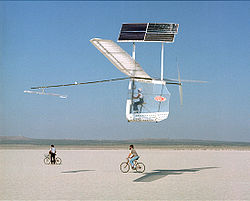Gossamer penguin
| Gossamer penguin | |
|---|---|

|
|
| Type: | Experimental airplane |
| Design country: | |
| Manufacturer: | |
| First flight: |
August 7, 1980 |
Gossamer Penguin was an experimental aircraft built by Paul MacCready's AeroVironment .
description
The "Penguin" was a version of the Gossamer Albatross II reduced to three quarters of the original size , with a wingspan of 21.64 meters and a weight, without a pilot, of 31 kg. The drive was the AstroFlight electric motor , which was powered by a 541 watt solar panel and powered by 3920 solar cells . It was the first solar powered pilot-carrying aircraft.
The initial flight tests were performed using 28 packs of nickel-cadmium batteries in place of the plates. The test pilot was Marshall MacCready, the son of Paul MacCready, weighing 80 pounds (36 kg).
The official pilot was Janice Brown, who weighed 100 pounds (45 kg). She piloted the penguin around 40 times prior to the public demonstration of a 1.95 mile (3.14 km) flight on August 7, 1980 at NASA Dryden Flight Research Center .
literature
- Klaus L. Schulte: Electric flight: technology, history, future , KLS Publishing, ISBN 978-3-942095-44-0 , pp. 136-137
- Kevin Desmond: Electric Airplanes and Drones: A History , McFarland, 2018, ISBN 978-1-4766-6961-8 , pp. 82-84
Web links
Individual evidence
- ↑ Anderson, Dale, Ian Graham, and Brian Williams. Flight and Motion: The History and Science of Flying. Routledge, 2015.
- ↑ PB Macready, PBS Lissaman, WR Morgan, JD Burke: Sun-powered aircraft designs. In: Journal of Aircraft. 20, No. 6, June 1983, pp. 487-493, ISSN 0021-8669 , doi: 10.2514 / 3.44898 .
- ^ Robert J. Boucher: History of solar flight. In: 20th Joint Propulsion Conference. American Institute of Aeronautics and Astronautics. 11-13 June 1984. doi: 10.2514 / 6.1984-1429 .
- ↑ Albatross ECN-13413: Solar-powered Gossamer Penguin in flight. In: dfrc.nasa.gov. Retrieved March 21, 2016 .